Peak Electrical Energy Consumption Prediction by ARIMA, LSTM, GRU, ARIMA-LSTM and ARIMA-GRU Approaches
Abstract
1. Introduction
2. Data
3. Models
3.1. LSTM
3.2. GRU (Gate Reccurent Unit)
- -
- the reset gate r determines the amount of information to be forgotten;
- -
- the update gate z defines the amount of information to keep (it works like the forget and input gate of an LSTM).
3.3. ARIMA
3.4. Hybrid Models
4. Methodology
5. Performance Evaluation
6. Results and Discussion
7. Conclusions
Author Contributions
Funding
Data Availability Statement
Acknowledgments
Conflicts of Interest
References
- Rallapalli, S.R.; Ghosh, S. Forecasting monthly peak demand of electricity in India—A critique. Energy Policy 2012, 45, 516–520. [Google Scholar] [CrossRef]
- Laouafi, A.; Mordjaoui, M.; Laouafi, F.; Boukelia, T.E. Daily peak electricity demand forecasting based on an adaptive hybrid two-stage methodology. Int. J. Electr. Power Energy Syst. 2016, 77, 136–144. [Google Scholar] [CrossRef]
- Hyndman, R.J.; Fan, S. Density Forecasting for Long-Term Peak Electricity Demand. IEEE Trans. Power Syst. 2010, 25, 1142–1153. [Google Scholar] [CrossRef]
- Pavlicko, M.; Vojteková, M.; Blažeková, O. Forecasting of Electrical Energy Consumption in Slovakia. Mathematics 2022, 10, 577. [Google Scholar] [CrossRef]
- Cao, X.; Dong, S.; Wu, Z.; Jing, Y. A Data-Driven Hybrid Optimization Model for Short-Term Residential Load Forecasting. In Proceedings of the 15th IEEE International Conference on Computer and Information Technology, CIT 2015, Liverpool, UK, 26–28 October 2015; pp. 283–287. [Google Scholar] [CrossRef]
- Fan, G.-F.; Wei, X.; Li, Y.-T.; Hong, W.-C. Forecasting electricity consumption using a novel hybrid model. Sustain. Cities Soc. 2020, 61, 102320. [Google Scholar] [CrossRef]
- Kandananond, K. Forecasting Electricity Demand in Thailand with an Artificial Neural Network Approach. Energies 2011, 4, 1246–1257. [Google Scholar] [CrossRef]
- Guenoupkati, A.; Salami, A.A.; Kodjo, M.K.; Napo, K. Short-Term Electricity Generation Forecasting Using Machine Learning Algorithms: A Case Study of the Benin Electricity Community (C.E.B). TH Wildau Eng. Nat. Sci. Proc. 2021, 1, 189–196. [Google Scholar] [CrossRef]
- Yalcinoz, T.; Eminoglu, U. Short term and medium term power distribution load forecasting by neural networks. Energy Convers. Manag. 2005, 46, 1393–1405. [Google Scholar] [CrossRef]
- Xiong, P.-P.; Dang, Y.-G.; Yao, T.-X.; Wang, Z.-X. Optimal modeling and forecasting of the energy consumption and production in China. Energy 2014, 77, 623–634. [Google Scholar] [CrossRef]
- Manowska, A.; Rybak, A.; Dylong, A.; Pielot, J. Forecasting of Natural Gas Consumption in Poland Based on ARIMA-LSTM Hybrid Model. Energies 2021, 14, 8597. [Google Scholar] [CrossRef]
- Zhou, S.; Song, C.; Zhang, J.; Chang, W.; Hou, W.; Yang, L. A Hybrid Prediction Framework for Water Quality with Integrated W-ARIMA-GRU and LightGBM Methods. Water 2022, 14, 1322. [Google Scholar] [CrossRef]
- Darwazeh, D.; Duquette, J.; Gunay, B.; Wilton, I.; Shillinglaw, S. Review of peak load management strategies in commercial buildings. Sustain. Cities Soc. 2022, 77, 103493. [Google Scholar] [CrossRef]
- Yildiz, B.; Bilbao, J.; Sproul, A. A review and analysis of regression and machine learning models on commercial building electricity load forecasting. Renew. Sustain. Energy Rev. 2017, 73, 1104–1122. [Google Scholar] [CrossRef]
- Siami-Namini, S.; Tavakoli, N.; Namin, A.S. A Comparison of ARIMA and LSTM in Forecasting Time Series. In Proceedings of the 2018 17th IEEE International Conference on Machine Learning and Applications (ICMLA), Orlando, FL, USA, 17–20 December 2018; pp. 1394–1401. [Google Scholar]
- Kolen, J.F.; Kremer, S.C. Gradient Flow in Recurrent Nets: The Difficulty of Learning Long Term. Dependencies 2001, 28, 237–243. [Google Scholar] [CrossRef]
- Kong, W.; Dong, Z.Y.; Jia, Y.; Hill, D.J.; Xu, Y.; Zhang, Y. Short-Term Residential Load Forecasting Based on LSTM Recurrent Neural Network. IEEE Trans. Smart Grid 2019, 10, 841–851. [Google Scholar] [CrossRef]
- Liu, X.; Lin, Z.; Feng, Z. Short-term offshore wind speed forecast by seasonal ARIMA—A comparison against GRU and LSTM. Energy 2021, 227, 120492. [Google Scholar] [CrossRef]
- Marino, D.L.; Amarasinghe, K.; Manic, M. Building energy load forecasting using Deep Neural Networks. In Proceedings of the IECON 2016-42nd Annual Conference of the IEEE Industrial Electronics Society, Florence, Italy, 23–26 October 2016; pp. 7046–7051. [Google Scholar] [CrossRef]
- Cho, K.; Van Merrienboer, B.; Bahdanau, D.; Bengio, Y. On the properties of neural machine translation: Encoder-decoder approaches. arXiv 2014, arXiv:1409.1259. [Google Scholar] [CrossRef]
- Fu, R.; Zhang, Z.; Li, L. Using LSTM and GRU neural network methods for traffic flow prediction. In Proceedings of the 2016 31st Youth Academic Annual Conference of Chinese Association of Automation (YAC), Wuhan, China, 11–13 November 2016; pp. 324–328. [Google Scholar]
- Zhang, Y.; Meng, G. Simulation of an Adaptive Model Based on AIC and BIC ARIMA Predictions Simulation of an Adaptive Model Based on AIC and BIC ARIMA Predictions. J. Phys. Conf. Ser. 2023, 2449, 012027. [Google Scholar] [CrossRef]
- As’ad, M. Finding the Best ARIMA Model to Forecast Daily Peak Electricity Demand. In Proceedings of the Fifth Annual ASEARC Conference—Looking to the future—Programme and Proceedings, University of Wollongong, Wollongong, NSW, Australia, 2–3 February 2012. [Google Scholar]
- Xu, D.; Zhang, Q.; Ding, Y.; Zhang, D. Application of a hybrid ARIMA-LSTM model based on the SPEI for drought forecasting. Environ. Sci. Pollut. Res. 2021, 29, 4128–4144. [Google Scholar] [CrossRef]
- Wang, Z.; Lou, Y. Hydrological time series forecast model based on wavelet de-noising and ARIMA-LSTM. In Proceedings of the 2019 IEEE 3rd Information Technology, Networking, Electronic and Automation Control Conference ITNEC 2019, Chengdu, China, 15–17 March 2019; pp. 1697–1701. [Google Scholar]
- Fan, D.; Sun, H.; Yao, J.; Zhang, K.; Yan, X.; Sun, Z. Well production forecasting based on ARIMA-LSTM model considering manual operations. Energy 2021, 220, 119708. [Google Scholar] [CrossRef]
- Pao, H. Forecasting energy consumption in Taiwan using hybrid nonlinear models. Energy 2009, 34, 1438–1446. [Google Scholar] [CrossRef]
- Debnath, K.B.; Mourshed, M. Forecasting methods in energy planning models. Renew. Sustain. Energy Rev. 2018, 88, 297–325. [Google Scholar] [CrossRef]
- Lee, J.; Cho, Y. National-scale electricity peak load forecasting: Traditional, machine learning, or hybrid model? Energy 2022, 239, 122366. [Google Scholar] [CrossRef]
- Sheng, F.; Jia, L. Short-Term Load Forecasting Based on SARIMAX-LSTM. In Proceedings of the 2020 5th International Conference on Power and Renewable Energy (ICPRE), Shanghai, China, 12–14 September 2020; pp. 90–94. [Google Scholar] [CrossRef]
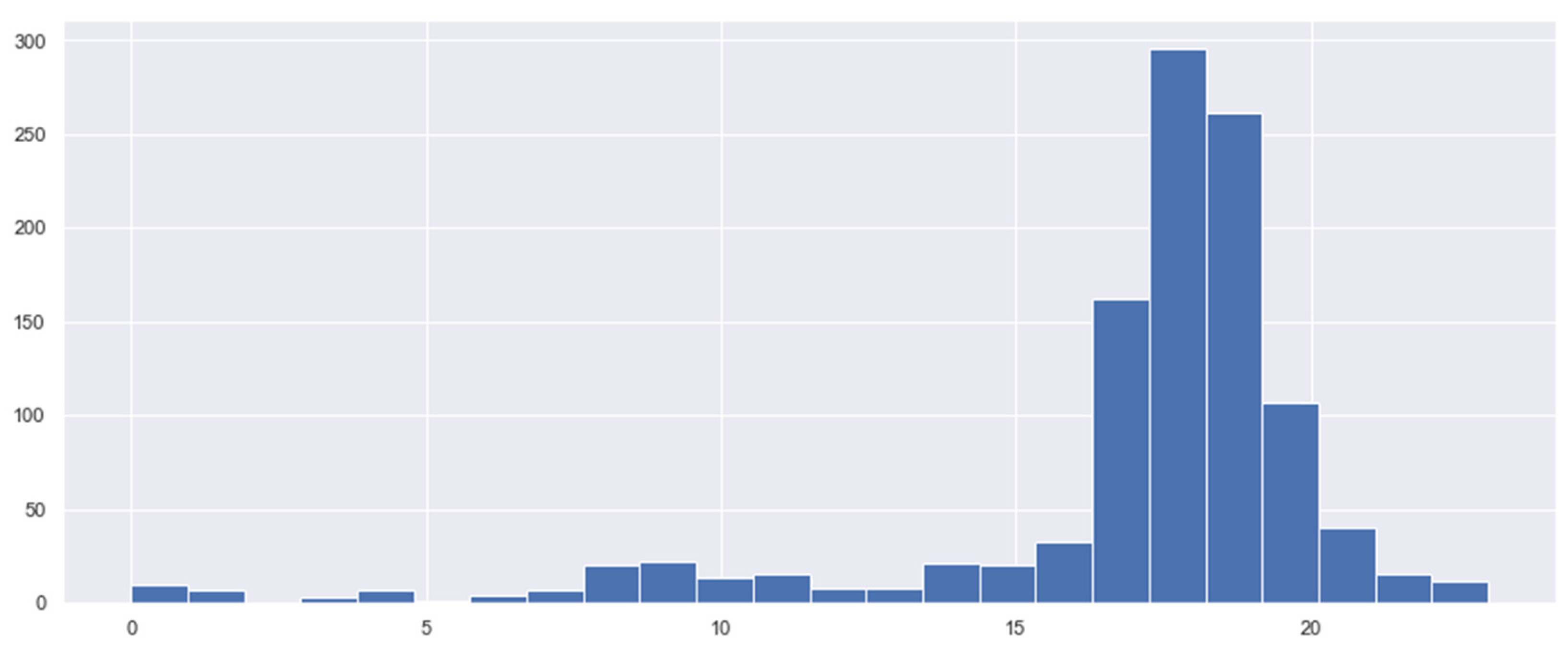
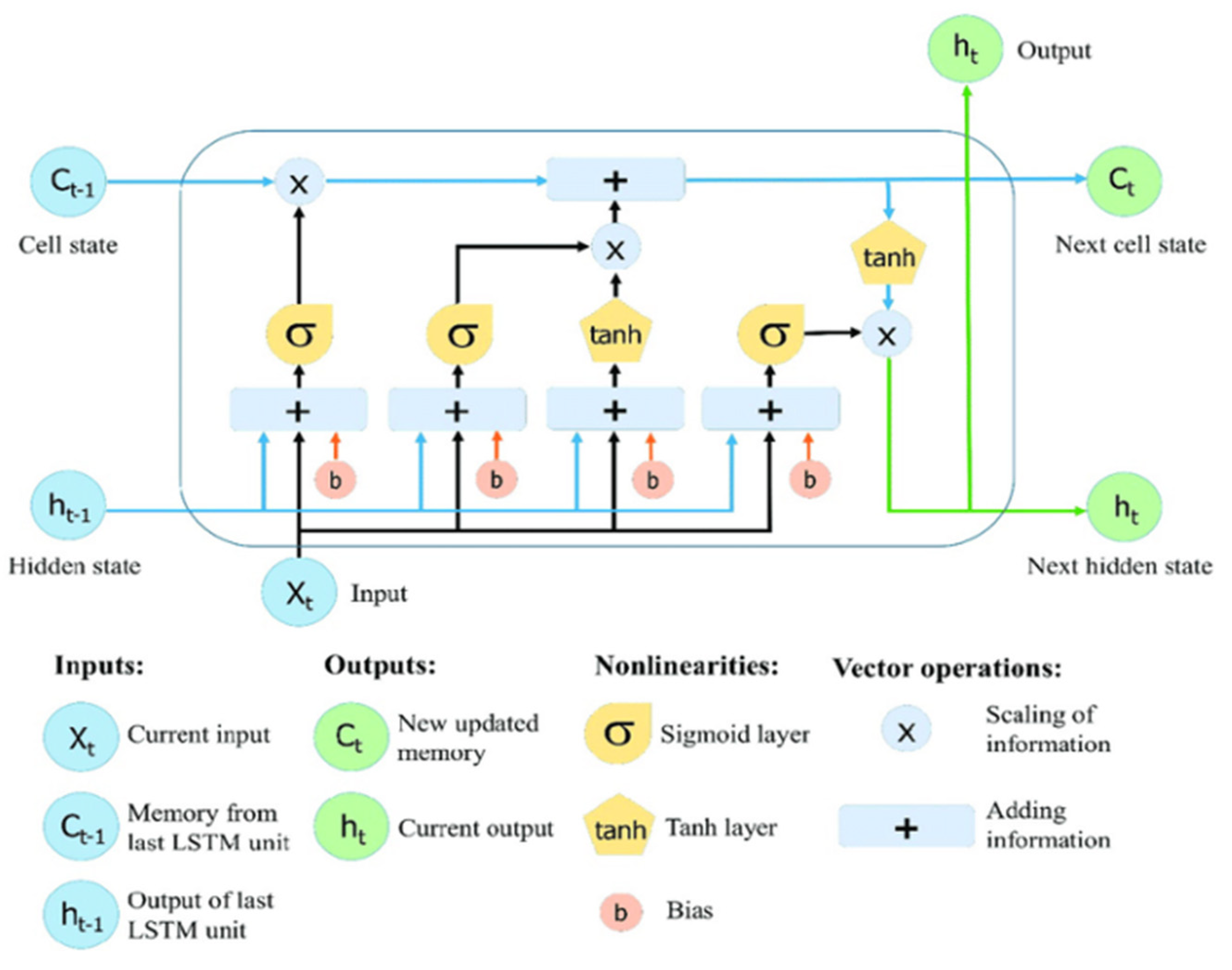
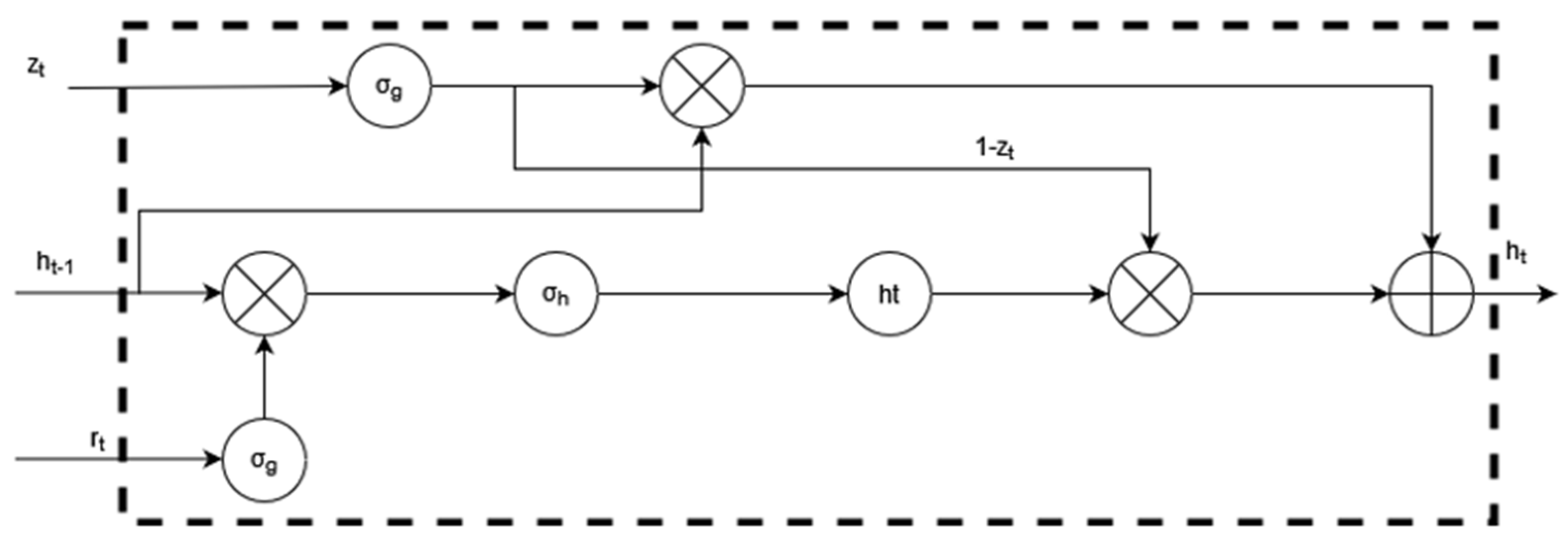

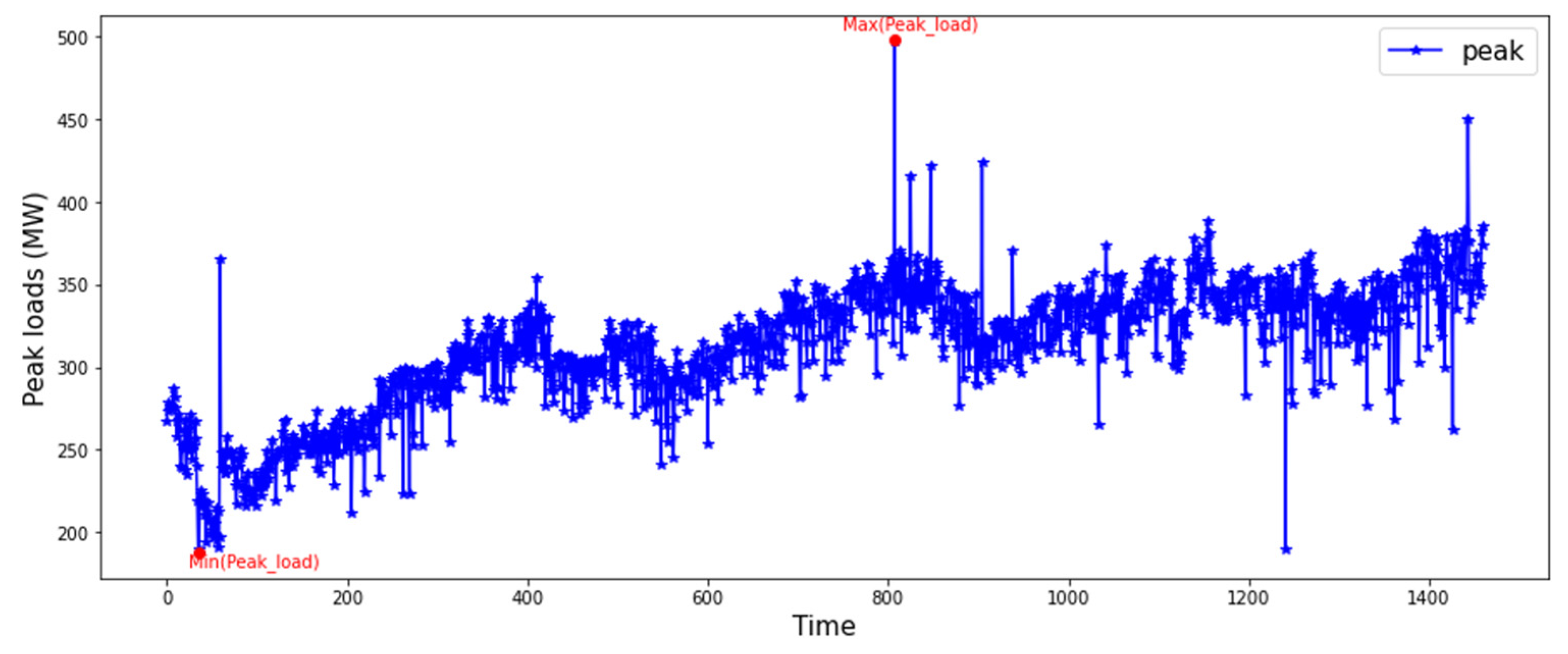
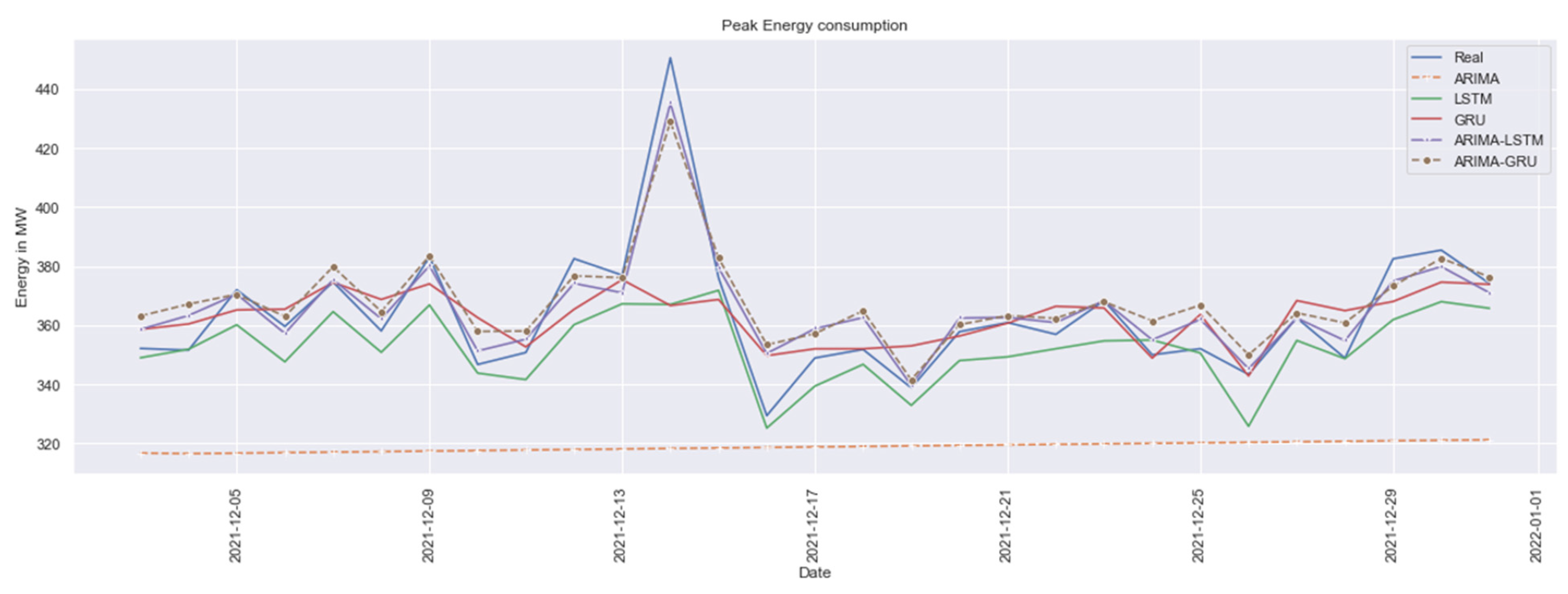
| Number | Min (MW) | Max (MW) | Mean (MW) | Std |
|---|---|---|---|---|
| 1461 | 178.77 | 497.48 | 312.05 | 38.83 |
| Approaches | ARIMA | LSTM | GRU | ARIMA-LSTM | ARIMA-GRU |
|---|---|---|---|---|---|
| RMSE | 49.90 | 18.74 | 18.11 | 7.35 | 9.60 |
| MAPE | 12.05 | 3.01 | 2.60 | 1.52 | 1.56 |
| Date | Peak_Real | Peak_ARIMA | Peak_LSTM | Peak_GRU | Peak_ARIMA-LSTM | Peak_ARIMA-GRU |
|---|---|---|---|---|---|---|
| 2021-12-03 | 352.11 | 316.68 | 348.95 | 358.56 | 358.55 | 363.10 |
| 2021-12-04 | 351.52 | 316.51 | 351.83 | 360.39 | 363.26 | 367.11 |
| 2021-12-05 | 371.95 | 316.66 | 360.11 | 365.15 | 370.46 | 370.44 |
| 2021-12-06 | 359.56 | 316.83 | 347.58 | 365.41 | 357.19 | 362.94 |
| 2021-12-07 | 374.59 | 317.00 | 364.55 | 374.46 | 375.40 | 379.78 |
| 2021-12-08 | 358.05 | 317.18 | 350.81 | 368.70 | 362.15 | 364.60 |
| 2021-12-09 | 383 | 317.35 | 366.82 | 373.98 | 380.09 | 383.44 |
| 2021-12-10 | 346.67 | 317.53 | 343.75 | 362.54 | 351.27 | 357.86 |
| 2021-12-11 | 350.72 | 317.70 | 341.56 | 352.63 | 355.22 | 358.00 |
| 2021-12-12 | 382.51 | 317.88 | 360.14 | 365.35 | 374.13 | 376.68 |
| 2021-12-13 | 376.92 | 318.05 | 367.21 | 375.39 | 370.96 | 376.08 |
| 2021-12-14 | 450.53 | 318.23 | 367.00 | 366.64 | 435.20 | 428.92 |
| 2021-12-15 | 376.01 | 318.40 | 371.77 | 368.68 | 379.47 | 382.77 |
| 2021-12-16 | 329.33 | 318.58 | 325.13 | 349.67 | 350.41 | 353.35 |
| 2021-12-17 | 348.88 | 318.75 | 339.35 | 351.98 | 358.80 | 357.13 |
| 2021-12-18 | 351.77 | 318.93 | 346.71 | 351.99 | 362.56 | 364.84 |
| 2021-12-19 | 338.77 | 319.10 | 332.83 | 352.98 | 339.57 | 341.48 |
| 2021-12-20 | 357.77 | 319.28 | 347.99 | 356.32 | 362.39 | 360.16 |
| 2021-12-21 | 360.86 | 319.45 | 349.27 | 360.67 | 362.60 | 363.24 |
| 2021-12-22 | 356.88 | 319.63 | 352.00 | 366.38 | 360.87 | 362.29 |
| 2021-12-23 | 368.28 | 319.80 | 354.67 | 365.81 | 368.24 | 367.92 |
| 2021-12-24 | 349.94 | 319.98 | 354.94 | 348.85 | 355.03 | 361.47 |
| 2021-12-25 | 352.02 | 320.15 | 350.55 | 363.58 | 361.93 | 366.76 |
| 2021-12-26 | 343.32 | 320.32 | 325.73 | 342.79 | 345.25 | 349.93 |
| 2021-12-27 | 362.46 | 320.50 | 354.81 | 368.31 | 362.41 | 364.12 |
| 2021-12-28 | 348.84 | 320.67 | 348.64 | 364.91 | 354.74 | 360.77 |
| 2021-12-29 | 382.46 | 320.85 | 361.85 | 368.00 | 374.94 | 373.22 |
| 2021-12-30 | 385.4 | 321.02 | 367.94 | 374.56 | 379.82 | 382.63 |
| 2021-12-31 | 374.1 | 321.20 | 365.71 | 373.83 | 370.94 | 376.33 |
Disclaimer/Publisher’s Note: The statements, opinions and data contained in all publications are solely those of the individual author(s) and contributor(s) and not of MDPI and/or the editor(s). MDPI and/or the editor(s) disclaim responsibility for any injury to people or property resulting from any ideas, methods, instructions or products referred to in the content. |
© 2023 by the authors. Licensee MDPI, Basel, Switzerland. This article is an open access article distributed under the terms and conditions of the Creative Commons Attribution (CC BY) license (https://creativecommons.org/licenses/by/4.0/).
Share and Cite
Pierre, A.A.; Akim, S.A.; Semenyo, A.K.; Babiga, B. Peak Electrical Energy Consumption Prediction by ARIMA, LSTM, GRU, ARIMA-LSTM and ARIMA-GRU Approaches. Energies 2023, 16, 4739. https://doi.org/10.3390/en16124739
Pierre AA, Akim SA, Semenyo AK, Babiga B. Peak Electrical Energy Consumption Prediction by ARIMA, LSTM, GRU, ARIMA-LSTM and ARIMA-GRU Approaches. Energies. 2023; 16(12):4739. https://doi.org/10.3390/en16124739
Chicago/Turabian StylePierre, Agbessi Akuété, Salami Adekunlé Akim, Agbosse Kodjovi Semenyo, and Birregah Babiga. 2023. "Peak Electrical Energy Consumption Prediction by ARIMA, LSTM, GRU, ARIMA-LSTM and ARIMA-GRU Approaches" Energies 16, no. 12: 4739. https://doi.org/10.3390/en16124739
APA StylePierre, A. A., Akim, S. A., Semenyo, A. K., & Babiga, B. (2023). Peak Electrical Energy Consumption Prediction by ARIMA, LSTM, GRU, ARIMA-LSTM and ARIMA-GRU Approaches. Energies, 16(12), 4739. https://doi.org/10.3390/en16124739









